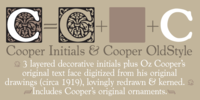Download Cooper Text Font Family

Cooper Text is a comprised of two fonts- Cooper OldStyle and Cooper Initials. Cooper OldStyle is a round-serifed text typeface, while Cooper Initials are ornamental capitals designed for use as complementary drop caps.
Cooper OldStyle has been lovingly redrawn from Oswald Bruce Cooper’s original drawings and mechanical proofs while Cooper Initials have been drawn from a sample in the seminal monograph of Cooper’s work, The Book of Oz.
More…
McArthur and Charles R. Murray having met with Oswald Cooper and his business partner Fred Bertsch in 1917. Due to other commercial design firms adopting Cooper’s style of lettering throughout the Midwest, both companies came to an agreement to create a family of types based on Cooper’s advertising lettering.
McArthur and Murray saw the biggest potential in the super-bold advertising lettering that would become Cooper Black, but agreed that a roman weight old style should be executed first, the logical progenitor to a family or related types.
This was the first of many tactical strategies in type design between type designer and foundry, most specifically McArthur and Cooper, whose back-and-forth relationship in designing, critiquing, and modifying letterforms was integral in shaping the oeuvre of type designs credited to Cooper.
While it was Cooper’s sheer talent in shaping appealing and useful alphabets that made his work so popular, McArthur’s role as critic and editor has gone largely un-noted in the slim amount of writing of length about Cooper’s work.
The capitals were successively redrawn by Cooper, with particular care paid to the “B” and “R” to make them relate formally. The lowercase was redrawn numerous times, as were experiments in shaping the punctuation.
McArthur requested a pair of dingbats to accompany the typeface, along with a decorative four leaf clover ornament “for luck”.
Originally called merely “Cooper” in early showings, the name was later revised to “Cooper Oldstyle”. The typeface met with a warm reception upon release in 1919, the public favoring its advertising-friendly, tightly-spaced appearance.
Sales were moderate, and the face was considered a success.
Early versions of drawings of the slimmer figures are noted as “cruel stuff” in accompanying notes by Cooper, though they were versioned out into far more elegant numerals than the earlier stout figures.
Both versions of the numerals are included in the digital release, as are the ornamental elements.
Cooper designed the initials open-faced on a square ground surrounded by organic ornament. The initials were “intended to be nearly even in ‘color value’ with that of normal text type”.
The letterforms themselves are a medium-bold variation on the Cooper OldStyle theme, lacking the balance of Cooper’s text faces, but charming nonetheless.
Cooper’s biography is delivered in English and Japanese with numerous full-color illustrations of never-before-published work.
No comments:
Post a Comment